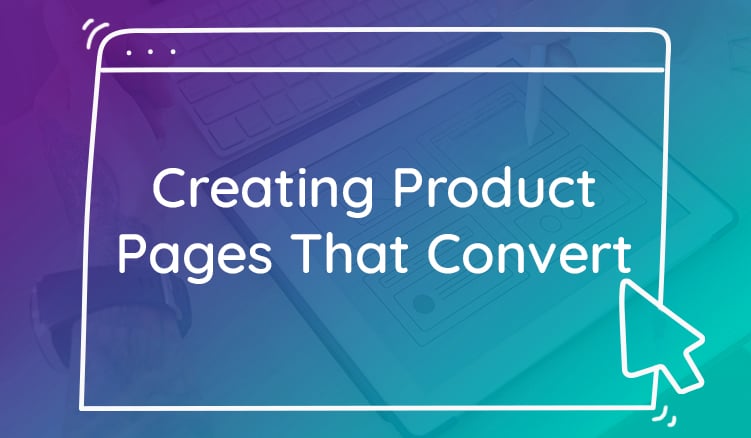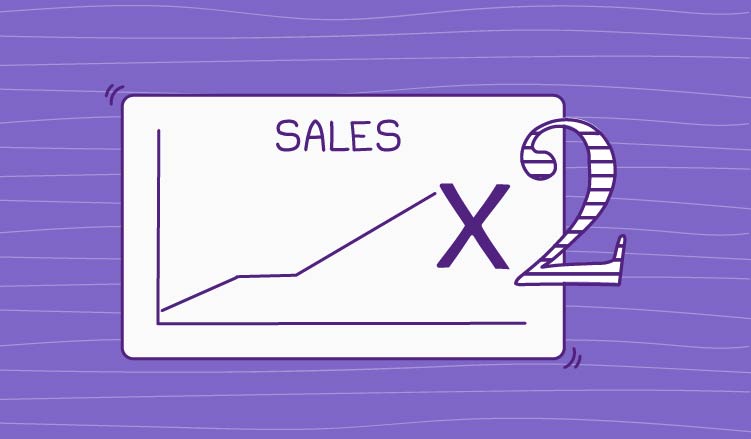When online shoppers consider your products, they can’t feel the quality of the fabric on a piece of clothing. They can’t smell the aroma of a candle. They can’t taste food or drinks to know if they’ll like it. Online shoppers have to rely on something else to help them make choices about the products they buy: data. And that’s what makes ecommerce merchandising so important for online retailers.
Understanding how to take advantage of ecommerce merchandising strategies can help you boost sales and customer loyalty. But there are so many ecommerce merchandising trends to choose from, how can you know what really works?
When online merchandising is done correctly, it should help you increase conversions and sales and give your customers a better overall experience. So let’s take a look at the brands that are already nailing both those things. These are some of the most successful brands in the ecommerce merchandising game, and we’ve highlighted the strategies they use so you can see what works. Put these strategies into play to get your own products flying off the (digital) shelves.
Best Merchandising Websites: Get Your Inspiration From These Brands That Are Nailing Ecommerce Merchandising
There’s no better place to learn the ropes of ecommerce merchandising than from the brands that are already crushing it. If you can implement some of the top brands’ strategies when merchandising your products, you’ll be well on your way to maximizing impact and increasing sales.
Rhone
 Image via https://www.rhone.com/
Image via https://www.rhone.com/
Strategies you can learn from:
- Enhanced browsing. Shoppers on Rhone’s website can sort products by price, size, fit—even what kind of technology the product features. Customers are able to search for exactly what they want.
- Detailed, high-res product photos. Rhone products are merchandised with visuals that show multiple angles and details. Customers know exactly what they’re getting when they make a purchase.
Boots
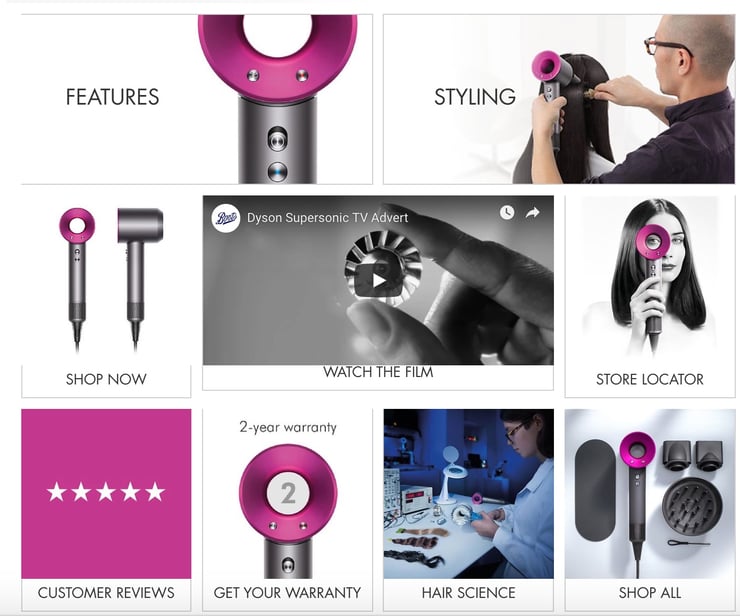
Image via https://www.boots.com/dyson/dyson-haircare
Strategies you can learn from:
- Video. Many of Boots’ electrical product pages include product demonstration videos created by the brands themselves. Video allows shoppers to see the product in action, and since the video is coming from the manufacturer, it’s a trusted source of data.
- Easy product discovery. Boots devotes a ton of its homepage real estate to featured products, sales, and more, making sure existing customers are constantly introduced to new products they may not have even known they needed.
Vanity Planet
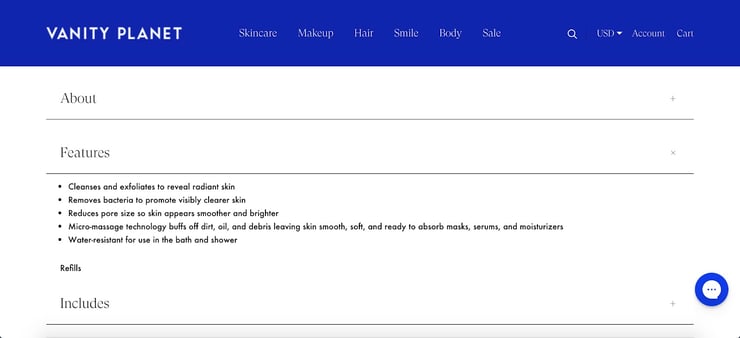
Image via https://www.vanityplanet.com/collections/skincare-devices/products/spin-for-perfect-skin
Strategies you can learn from:
- Extensive, well-organized product descriptions. Descriptions are bulleted and separated into sections that provide different levels of detail. Customers can easily see if products meet their needs.
- Tons of product reviews. Some products have tens of thousands of reviews, so shoppers can see what people who have already purchased the products think of them.
Nespresso
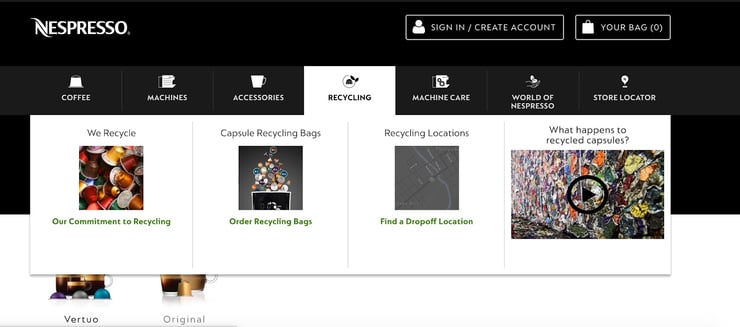 Image via https://www.nespresso.com/us/en/home
Image via https://www.nespresso.com/us/en/homeStrategies you can learn from:
- Connecting with what’s important to your customers. Nespresso goes deeper than just merchandising its products; it dedicates a large section of its website to deeply explain the company’s recycling and sustainability practices. This fosters extra loyalty with the many online shoppers who are conscious of their impact.
- Homepage storytelling. Nespresso’s homepage features more than just products—it also delves into the brand’s social responsibility campaigns, coffee masterclasses it offers, how and why Nespresso is changing the at-home coffee game—you get the idea. It tells the who, what, and why of the brand, which helps customers invest in the brands they love and will return to.
Pura Vida
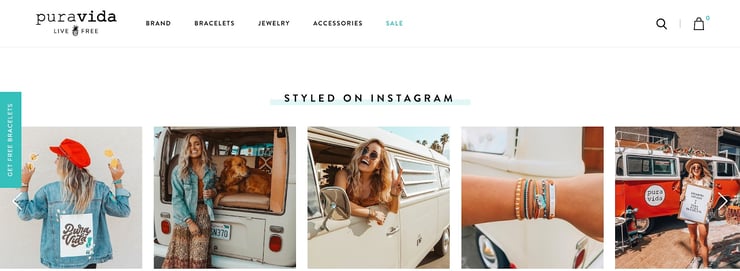
Strategies you can learn from:
- Recognizable, branded design. Pura Vida as a brand is all about fun and adventure, and its design conveys that perfectly.
- Mobile adaptation. More and more shoppers are doing their browsing and purchasing on smartphones and tablets, and Pura Vida’s website seamlessly responds to whatever device the customer is on when they shop.
- Honing in on your target audience. Pura Vida embraces the adventurous spirit of its core customers by integrating their Instagram shots into product pages. It gets customers involved, and it shows how the products look in the wild, and it resonates with young, adventurous people—the people Pura Vida wants to sell to.
Need More Ecommerce Merchandising Strategies?
Now that you’ve seen some of the top ecommerce merchandising strategies in action, here are some other strategies your brand can implement to get on the same level as these companies.
Stand for Something, in Your Visuals and Your Copy
What makes all those brands above such successful merchandisers? Their photography and copy all exude the things their brands stand for. Successful brands are instantly recognizable in their visual and written messages. Use a voice in your copy that matches the message you want to send to your potential customers (whether that’s a serious voice or one that’s got nothing but jokes). Use your visuals and copy to appeal to the emotional part of your customers’ brains, because that’s the part that will ultimately get them to click “Add to Cart.”
Use Social Proof
The user generated content the above brands used is one great form of social proof—it shows that people use and love the products they’re sharing photos of.
You can also use other forms of proof, like reviews and testimonials, visitor or sales numbers or links to your brand’s social media pages that show how many people like and follow you.
Entice Buyers With Offers Right On Your Homepage
Your homepage is often the first encounter potential customers have with your brand. Entice them to convert by offering a deal right there on the homepage. Something like a discount code for first-time shoppers or a free shipping code will do the trick.
Use Your Search Functions to Make Things Easy
Everyone loves instant gratification. So make it fast and easy for shoppers to find exactly what they’re looking for on your site. Use autocomplete in your search bars. Take them to products that match all their search queries (for example, if they search for red high heeled shoes, don’t show them red sneakers or sandals). If shoppers know what they’re looking for, make it easy for them to find it with as few clicks as possible.
Offer Comprehensive Navigation Menus
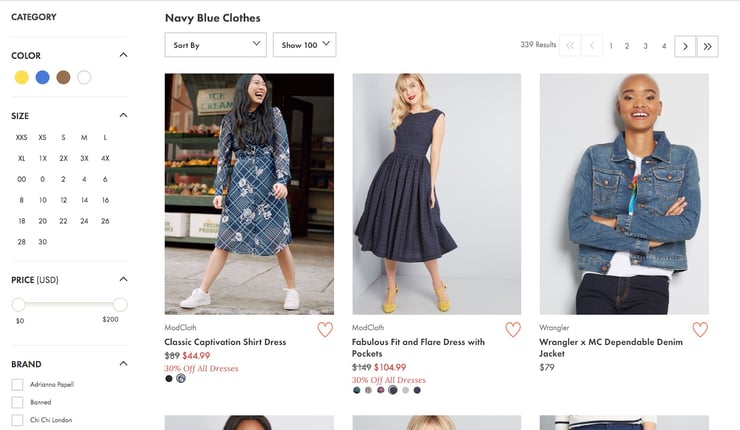
Image via https://www.modcloth.com/shop/navy-blue-clothing
For customers who aren’t so sure what they’re looking for, offer a comprehensive navigation menu that lets them narrow down products by all kinds of criteria: size, color, material, features, price, and more. Bonus points if the menu is on the left-hand side of the page so the customer doesn’t need to do any extra scrolling to find it.
Use Content Merchandising to Get People in a Shopping Mood

Image via https://www.wayfair.com/
Creating original content can help convert shoppers, like how Wayfair offers styled room designs to inspire shoppers and entice them to make multiple purchases per visit.
Spark Loyalty In Return Customers
Like the Marie Kondo of merchandising, you can spark joy loyalty in return customers with a few simple tactics that make it easy for them to pick up where they left off the last time they shopped your site.
Show a reminder for items in their cart that they didn’t purchase. Have a section on product pages to show products they’ve viewed most recently. Offer a promotion on products on their wishlist. Add an “Order Again” button to their past orders page. Whatever it takes to turn a first-time purchaser into a loyal, repeat customer.
Encourage Browsers to Make a Purchase
Many online shoppers spend hours browsing site offerings without ever really intending to buy anything. When people browse your site, you want to make purchasing something irresistible. One easy way to do this is to promote your best-selling products. This is a psychological trick that makes shoppers feel like if others have to have those products, they do too. Another good trick is to offer a discount code pop-up to shoppers who have been browsing for a certain amount of time.
Feature Products as Collections
To encourage shoppers to make more purchases with each visit, group your items together in collections. This will work especially well if the items in a collection all complement one another or work together (for example, shoes and a belt in a matching shade of leather).
Offer Complementary Products
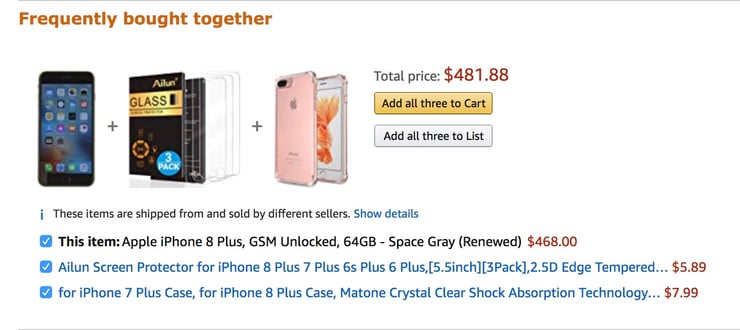
Image via https://www.amazon.com/Apple-iPhone-Plus-Unlocked-64GB/
On product pages, add a section for products that will go well with what the shopper is already viewing (“People who bought this also bought…”). Display similar complementary products in the customer’s cart—once they’ve decided to purchase one product, it’ll be easier to sway them to purchase another product that goes with it.
Use the Right Data
When it comes to creating a customer experience that will make every shopper click “purchase” and return to your store over and over, personalizing the experience is key. That means tracking a lot of detailed customer information and using it to optimize your marketing and merchandising efforts.
Ecommerce Merchandising and Product Information Management
As you can see, there’s a virtually endless number of digital merchandising terms and strategies you can put into play. And good merchandising requires keeping track of a lot of data, on both your products and your customers.
You need a good way to organize all that data. Product information management software can help you centralize, optimize, distribute and analyze all the thousands of data points necessary to get your products in the hands of the people who want and need them.
Ecommerce merchandising is a complex and inexact science. But by looking to successful brands using some of the most popular tactics they employ, you too can create a site full of products shoppers won’t be able to wait to get their hands on.


